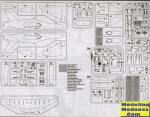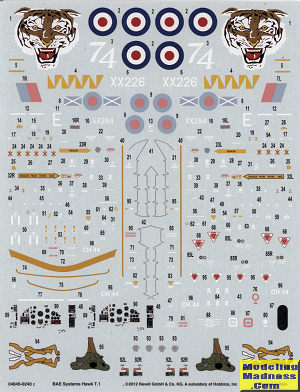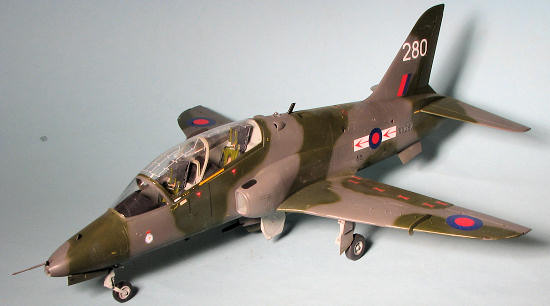
| KIT #: | 04849 |
| PRICE: | $25.00 'used' |
| DECALS: | Two options |
| REVIEWER: | Scott Van Aken |
| NOTES: |

| HISTORY |
The Hawk is a tandem two-seat aircraft and has a low-mounted cantilever monoplane wing and is powered by a non-augmented turbofan engine. The low-positioned one-piece wing was designed to allow a wide landing gear track and to enable easier maintenance access. The wing is fitted with wide-span, double-slotted, trailing-edge flaps for low-speed performance. Integral to the wing is 836 litre (184 imp gal) fuel tank and room for the retractable main landing gear legs. Designed to take a +8/-4 g load, the original requirement was for two stores hardpoints but it was designed to fit four hardpoints by Hawker Siddeley.
The fuselage design was led by the need to get a height differential between the two tandem cockpits; this enabled increased visibility for the instructor in the rear seat. Each cockpit is fitted with a Martin-Baker Mk 10B zero-zero rocket-assisted ejection seat. The centre fuselage has an 823-litre (181 imp gal) flexible fuel tank. The two-shaft turbofan Rolls-Royce Turbomeca Adour engine is fitted in the rear-fuselage with inlets on each side above the forward wing roots. A ram air turbine is fitted just in front of the single fin as well as a gas turbine auxiliary power unit above the engine. The forward retracting landing gear leg is fitted in the nose.
The Hawk was designed to be manoeuvrable and can reach Mach 0.88 in level flight and Mach 1.15 in a dive, thus allowing trainees to experience transonic flight before advancing to a supersonic trainer. Its airframe is very durable and strong, stressed for +9 g but the normal limit in RAF service is +7.5/-4 g.
The Hawk is designed to carry a centreline gun pod (normally a 30 mm ADEN cannon) and two under-wing pylons. Most Hawks use the two hardpoints but the aircraft is designed to carry four. The RAF has used the under-wing pylons to carry Sidewinder air-to-air missiles.
The Hawk is still in production with over 900 Hawks sold to 18 customers around the world. 80 of the original 178 T.1 fleet have been overhauled with new center and aft fuselages from the T.60 series. First deliveries of the Hawk to the RAF were in late 1976, making some airframes over 35 years old. The RAF is currently taking deliveries of the much less aesthetically pleasing Hawk T.2. Most earlier T.1/A Hawks have been retired from the RAF.
| THE KIT |
 Revell
has become probably the most prodigious maker of 1/32 aircraft kits. Unlike some
of the other more recent 1/32 kit makers, Revell seems to feel that there is
merit in doing subjects that are not strictly WWII. They also do not seem to go
for the myriad of variant boxings that one sees from Eduard and Dragon.
Revell
has become probably the most prodigious maker of 1/32 aircraft kits. Unlike some
of the other more recent 1/32 kit makers, Revell seems to feel that there is
merit in doing subjects that are not strictly WWII. They also do not seem to go
for the myriad of variant boxings that one sees from Eduard and Dragon.  It is nice that the lower wing is in a single piece with the control surfaces as
part of the upper wings. In fact, one builds up the wheel wells in the upper
wing before attaching the wing sections. Though the rudder seems to be movable,
all the other control
surfaces are
in the neutral position. This is typical of the type on the ground. Also typical
are lowered inner gear doors. The kit has a separate speed brake that can be
posed open, but this is not typical.
It is nice that the lower wing is in a single piece with the control surfaces as
part of the upper wings. In fact, one builds up the wheel wells in the upper
wing before attaching the wing sections. Though the rudder seems to be movable,
all the other control
surfaces are
in the neutral position. This is typical of the type on the ground. Also typical
are lowered inner gear doors. The kit has a separate speed brake that can be
posed open, but this is not typical.| CONCLUSIONS |

| REFERENCES |
http://en.wikipedia.org/wiki/Bae_Hawk
Aeroguide #1: BAe Hawk, 1983
February 2024
Copyright ModelingMadness.com. All rights reserved. No reproduction in part or in whole without express permission from the editor.
If you would like your product reviewed fairly and fairly quickly, please contact the editor or see other details in the Note to Contributors.